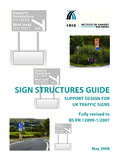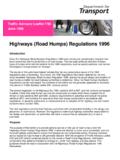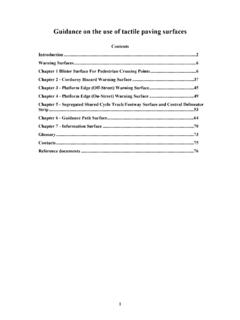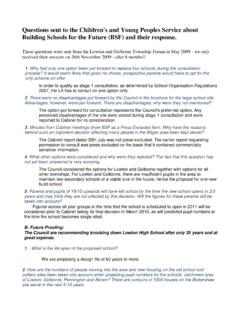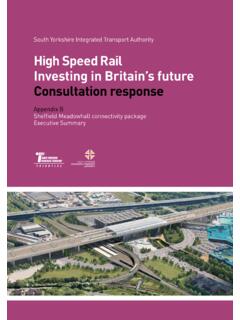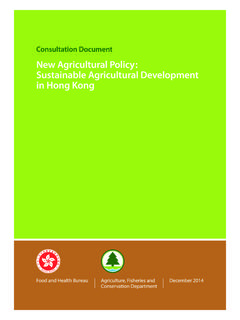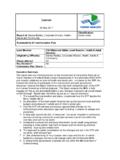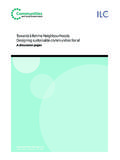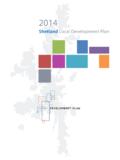Transcription of Department for Transport - LTN 2/04 - Adjacent …
1 Department for Transport - LTN 2/04 - Adjacent and shared Use facilities for Pedestrians and cyclists LTN 2/04 - Adjacent and shared Use facilities for Pedestrians and cyclists Table of contents 1. Introduction General Background 2. Using This Local Transport Note General 3. Evaluation Introduction Identifying the need for a cycle route Checking the feasibility of on-road solutions for cyclists Demonstrating the case for an Adjacent or shared use solution 4. Site Assessment Introduction Initial surveys Site Assessment Record Site Assessment Option Assessment Locations without existing footpaths or footways 5. Consultation General Requirements 6. Design Segregation Width requirements Provision alongside carriageways 7. Selecting the Scheme Option selection User audit 8. Associated facilities Road crossings -1- Department for Transport - LTN 2/04 - Adjacent and shared Use facilities for Pedestrians and cyclists Pedestrianised areas Subways and bridges Towing paths 9.
2 General Design Requirements Introduction Sightlines Cycle tracks Adjacent to the carriageway Signing, marking and information Maintenance Street furniture Lighting 10. Other Issues Legal status Enforcement Legal status of various Transport devices Post implementation 11. Key References and Useful Addresses General Walking and cycling design Policy, strategy and legislation Research into combined pedestrian and cycle use Useful addresses 1. Introduction General Local Transport Note (LTN) 2/86 shared Use by cyclists and Pedestrians, DoT 1986, provided guidance regarding the appropriateness of shared use as a way of creating cycle routes. This LTN replaces LTN 2/86. It reiterates and strengthens the earlier guidance that before considering the introduction of an Adjacent or shared use facility along an existing pedestrian route, all possibilities must be explored for improving conditions for cyclists within the carriageway.
3 However, it should be noted that this approach does not apply to entirely new, well designed facilities which complement the existing network and improve conditions for all types of user. The title for this document has changed from that of LTN 2/86. This reflects the need to clarify the distinction between segregated and unsegregated use. Routes generally used by pedestrians and cyclists only, are now referred to as Adjacent or shared use routes. Adjacent use exists where a cycle track is provided in close proximity to a footway or footpath but is segregated from it in some way. The term shared use has now been re-defined to describe a route over which there is no segregation between cyclists and pedestrians. -2- Department for Transport - LTN 2/04 - Adjacent and shared Use facilities for Pedestrians and cyclists This LTN should principally be used as guidance for routes within built up areas, where the predominant function of the route is for utility Transport , and where use by pedestrians and/or cyclists is likely to be frequent.
4 Specific guidance on introducing cycle routes along rights of way in rural areas where urban-style engineering measures can be intrusive is available from the Countryside Agency and Sustrans. Additional guidance about catering for non motorised users on trunk roads is available from the Highways Agency. Although some routes are purpose built, many are created through the conversion or widening of existing pedestrian footways or footpaths. Converting a footway or footpath to allow use by cyclists should only be done after a rigorous assessment has been carried out. It is vital to ascertain whether it is the best option or not. This can only be done after all on-road solutions have been fully considered and rejected as unsuitable. If so, the conversion must be carefully designed to meet the needs, as far as is practicable, of all its intended users. Footways and footpaths have a legal definition (see Annex B) but, in essence, a footway is a pedestrian right of way within the boundary of an all-purpose highway (usually called the pavement) and a footpath is one outside it.
5 Background The government's white paper A New Deal for Transport : Better for Everyone, DETR 1998, states that a key element of an integrated Transport strategy is to make it easier for people to walk or cycle for short journeys. These modes have been given a higher priority with the introduction of Local Transport Plans (LTPs). The level of funding enables local authorities to provide good quality facilities for both types of user. Tomorrow's Roads: Safer for Everyone, the Government's Road Safety Strategy and Casualty Reduction Targets for 2010, DETR 2000, highlights that improving safety for vulnerable road users is crucial in promoting the feasibility of these forms of Transport . The Department for Transport (DfT) seeks to promote walking for short journeys, and as an integral part of longer journeys involving other modes of Transport . It is therefore important to ensure that Adjacent or shared use facilities are not introduced in such a way as to discourage walking trips.
6 This is a vital component of the DfT's shared use policy. It is endorsed in the government's Guidance on Full Local Transport Plans, DETR 2000, which aims to encourage walking and cycling and recommends that a good LTP should include policies and schemes that minimise conflict between pedestrians and cyclists . The National Cycling Strategy (NCS), DoT 1996 contains a wide variety of actions to promote cycling and sets targets for increased cycle use. The NCS seeks to encourage and enable planning and highway authorities to provide a Transport network that is safe and convenient for cycling, and attractive for new cyclists . It recognises that for the most part this will come about through changes and improvements to the existing road network. Following consultation on its discussion document On the move: by foot, DfT is preparing for publication in 2004 an action plan which will set out a series of measures to promote and improve provision for walking and cycling.
7 -3- Department for Transport - LTN 2/04 - Adjacent and shared Use facilities for Pedestrians and cyclists 2. Using This Local Transport Note General LTN 1/04, Policy, Planning and Design for Walking and Cycling, DfT 2004, provides advice on the design and implementation of good quality infrastructure improvements to encourage walking and cycling in England and Wales. It shows the underlying policy and design principles to be taken into consideration when considering infrastructure measures for use by pedestrians and cyclists , and gives examples of ways in which the policies and principles translate into schemes on the ground. LTN 1/04, through its "hierarchies of provision", emphasises the need to consider other options before contemplating Adjacent or shared use routes. The designer should first check whether cyclists can be catered for within the existing carriageway and if not, how the carriageway might be modified to bring this about.
8 If acceptable provision for cyclists cannot be achieved within the carriageway, a more detailed assessment is required to identify and justify the need for off-road provision and to determine the most desirable form of shared use facility. A major aim of this LTN is to introduce a more robust system for practitioners to evaluate and justify the need for shared use. It provides guidance on assessment, planning, and design aspects of Adjacent and shared use. It consolidates existing advice from a variety of sources and reflects the findings of research, consultation and recent policy initiatives for walking and cycling. The decision making process from LTN 1/04 is summarised in the following flow-chart and is explained in more detail in Chapter 3. If the scheme assessment indicates the need for shared use but due to physical constraints it proves impracticable to construct such a facility, the guidance takes the user back to consideration of on-road provision, or even whether a cycling facility should be provided at all.
9 Decision making Flowchart 3. Evaluation Introduction Schemes that involve Adjacent or shared use of space between pedestrians and cyclists may be contentious, particularly when the scheme introduces cyclists into areas previously reserved solely for pedestrians. Appropriate consultation and good design can help to improve the quality, and hence the acceptance of shared facilities . The starting point is to consider the design principles outlined in LTN. 1/04, which set out the underlying policy issues and planning criteria for pedestrians and cyclists , based on the design requirements for each mode. -4- Department for Transport - LTN 2/04 - Adjacent and shared Use facilities for Pedestrians and cyclists Practitioners involved in the investigation, design and implementation of cycle facilities need to understand the procedural structure of the evaluation. The process can be summarised thus: identify the need for a cycle route within a particular corridor.
10 Check for possible on-carriageway solutions;. if an on-carriageway solution cannot be achieved, conduct a site assessment to determine whether Adjacent or shared use is feasible; and if it is feasible, determine what form the facility should take. If not, check again for on-carriageway solutions or alternative alignments. Ultimately, retaining the current arrangement may be the preferred course of action. Identifying the need for a cycle route The first element is to evaluate the strategic need for cycle routes on an area wide basis. Cycle routes should always link existing and proposed trip attractors/generators. They should only be provided where there is (or will be) a demand for local trips and not simply because an opportunity exists to do so. An exception to this is new routes intended for leisure cycling where the cycle track itself may be the attraction - but even in this case the routes should ideally form part of either a local network or the National Cycle Network.

